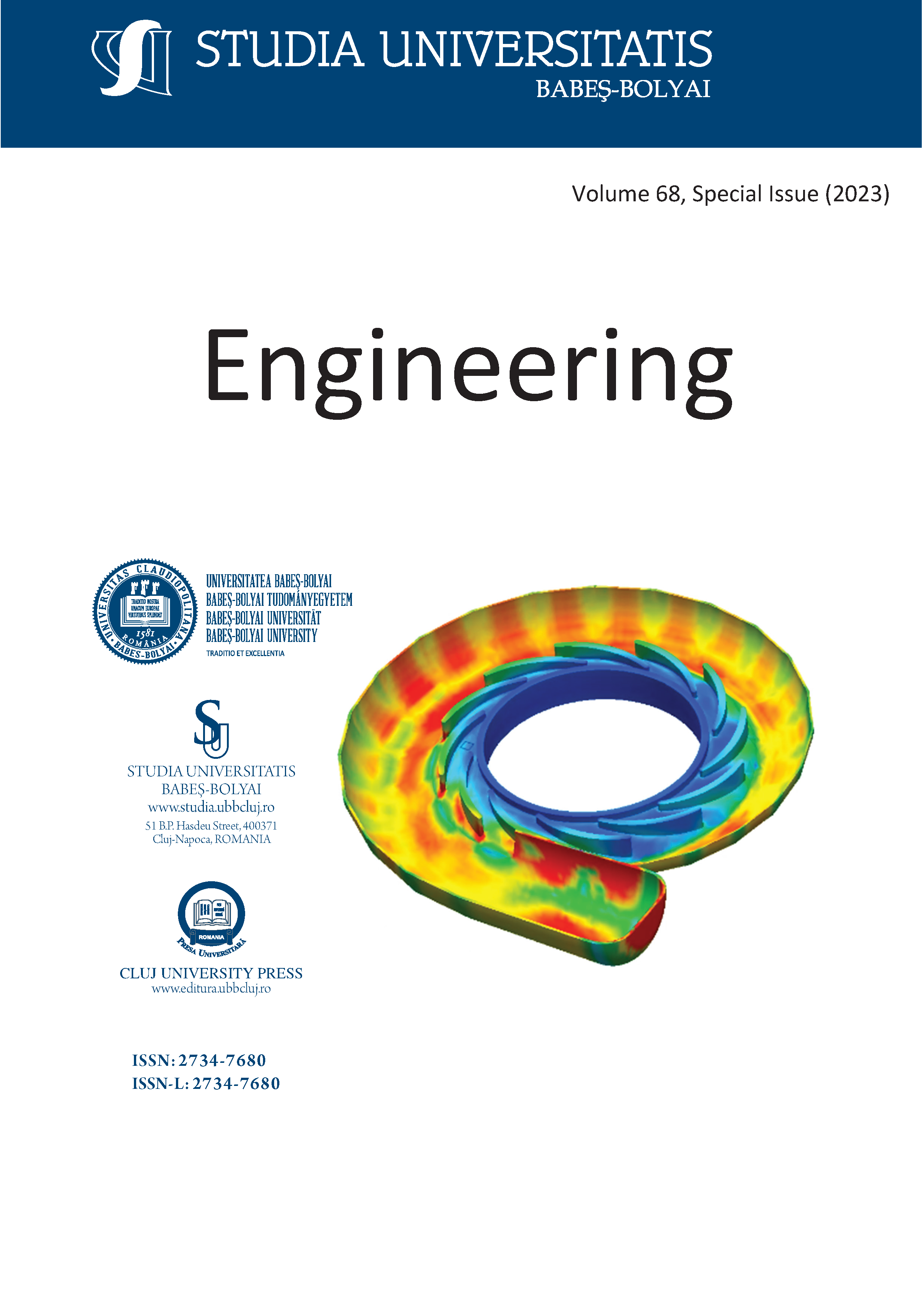Determining the Temperature Using Natural Frequencies and Artificial Intelligence
DOI:
https://doi.org/10.24193/subbeng.2023.spiss.2Keywords:
temperature, natural frequency, artificial intelligence, finite element method, thermal conditionAbstract
The current paper explores a novel approach for determining temperature variations by integrating the modal parameters and AI techniques. The research focuses on the development of a comprehensive dataset for training an AI model encompassing an analytical method that considers thermal conditions and natural frequencies. Traditional methods of temperature measurement, like infrared and platinum resistance thermometers, often face limitations in terms of accuracy, especially in complex or dynamic environments having an uncertainty of ±3.6°C [1], respectively ±0.2°C [2]. In this study, we propose a methodology that harnesses the inherent relationship between axial loads caused by temperature variations and the change in natural frequencies of a double clamped steel beam. The measured natural frequency data is collected and fed into the AI model, specifically, for a robust temperature estimation, obtaining a maximum predicted temperature deviation of 0.386°C.
References
Shuanglong C., Bojun S., Xiaogang S., A method for improving temperature measurement accuracy on an infrared thermometer for the ambient temperature field, Review of Scientific Instruments, 91, 054903, 2020.
BS1041-2.1:1985 Temperature Measurement- Part 2: Expansion thermometers. Section 2.1 Guide to selection and use of liquid-in-glass thermometers.
Cornwell P., Farrar C.R., Doebling S.W., Sohn H., Environmental variability of modal properties, Experimental Techniques, 23(6), 1999, pp. 45–48.
Tufoi M., Gillich G.R., Praisach Z.I., Iancu V., Furdui H., About the influence of temperature changes on the natural frequencies of clamped-clamped euler-bernoulli beams, Romanian Journal of Acoustics and Vibration, 11, 2014, pp. 84-87.
Azadi M., Free and forced vibration analysis of FG beam considering temperature dependency of material properties, Journal of Mechanical Science and Technology, 25(1), 2011, pp. 69-80.
Soo Lon Wah W., Xia Y., Elimination of outlier measurements for damage detection of structures under changing environmental conditions, Structural Health Monitoring, 571(1), 2011.
Liu H., Wang X., Jiao Y., Effect of temperature variation on the modal frequency of reinforced concrete slab and beam in cold regions, Shock and Vibration, 6, 2016, pp. 1-17.
Yijiang M., Guoping C., Modal analysis of a rectangular variable cross-section beam with multiple cracks under different temperatures, Journal of Vibroengineering, 18., 2016, pp. 3078-3088, 10.21595/jve.2016.16676.
Cai Y., Zhang K., Ye Z., Liu C., Lu K., Wang L., Influence of Temperature on the Natural Vibration Characteristics of Simply Supported Reinforced Concrete Beam, Sensors (Basel), 21(12), 2016, pp. 4242, doi: 10.3390/s21124242. PMID: 34205726; PMCID: PMC8234513.
Sohn H., Dzwonczyk M., Straser E.G., Kiremidjian A. S., Law K., Meng T., An experimental study of temperature effect on modal parameters of the Alamosa Canyon Bridge, Earthquake Engineering and Structural Dynamics, 28(7-8), 1999, pp. 879–897.
Farrar C. R., Doebling S.W., Cornwell P. J., Straser E. G., Variability of modal parameters measured on the Alamosa Canyon bridge,” in Proceedings of the 15th International Modal Analysis Conference (IMAC ‘97), pp. 257–263, Orlando, Fla, USA, February 1997.
Khangamlung K., Muhammad A.K., Kamran A.K., Characterising modal behaviour of a cantilever beam at different heating rates for isothermal conditions, Applied Sciences, 11, 2021, p. 11104, https://doi.org/10.3390/app11104375biographies.
Gillich G.R., Furdui H., Wahab M.A., Korka Z.I., A robust damage detection method based on multi-modal analysis in variable temperature conditions, Mechanical Systems and Signal Processing, 115, 2019, pp. 361–379, https://doi.org/10.1016/j.ymssp.2018.05.037
Gillich N., Tufisi C., Sacarea C., Rusu C.V., Gillich G.R., Praisach Z.I., Ardeljan M., Beam Damage Assessment Using Natural Frequency Shift and Machine Learning, Sensors, 2022, 22(3):1118.
Downloads
Published
How to Cite
Issue
Section
License
Copyright (c) 2023 Studia Universitatis Babeș-Bolyai Engineering

This work is licensed under a Creative Commons Attribution-NonCommercial-NoDerivatives 4.0 International License.





 © Studia Universitatis Babeş-Bolyai Engineering. Published by Babeș-Bolyai University.
© Studia Universitatis Babeş-Bolyai Engineering. Published by Babeș-Bolyai University.